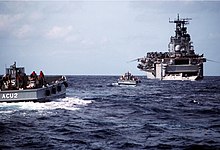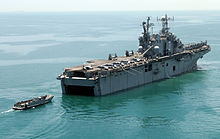Tarawa class
 The 1997 Tarawa off California |
|
| Overview | |
|---|---|
| Type | Amphibious assault ship |
| units | 5 built |
| Namesake | Tarawa Island |
| period of service |
1976-2015 |
| Technical specifications | |
| displacement |
39,925 tons |
| length |
249.9 meters |
| width |
32.3 meters |
| Draft |
8.2 meters |
| crew |
82 officers, 882 sailors, up to 1894 troops |
| drive |
2 propellers, driven by 2 steam turbines; 70,000 wave horsepower |
| speed |
20+ knots |
| Range |
10,000 nautical miles at 20 knots |
| Armament |
2 starter RAM , various guns |
The Tarawa- class were amphibious assault ships of the United States Navy . Their designation LHA stands for Landing Deck, Helicopter Assault . In addition to helicopters, the ships also transport landing craft . The class is named after the island of Tarawa , where the US Marines in World War II in the Battle of Tarawa have fought.
history
Planning and construction
Planning for the Tarawa class began in the mid-1960s. What was planned was the largest class of amphibious assault ships in terms of space and weight. They complemented the ships of the Iwo Jima class, built purely as helicopter carriers . As such, it formed the basis for a new philosophy in the US Navy. Previous landing operations had to be carried out with multiple classes providing landing craft, equipment and helicopter support for the landing forces. So that could Landing Platform Docks of Austin-class record only a very limited number of transport helicopters, the ships of the Tarawa-class could also mixed helicopters groups are embarked with attack capabilities. Special cargo ships, so-called amphibious cargo ships , became obsolete with the development of the Tarawa class .
In 1968 the contract was awarded to Ingalls Shipbuilding as a so-called Total Package System (i.e. the entire class is built by a shipyard) . This shipyard built the ships in a modular way: the hull was made in four sections, which were later put together and supplemented with the island section to form a finished unit. Originally, a unit was expected to cost around US $ 160 million, but delays during construction and high inflation resulted in a unit costing around US $ 300 million. Another reason for the price increase was the decision of the Navy in 1971 to reduce the class from nine to just five units.
Present and Future
The Tarawa-class ships entered service between 1976 and 1980 and were originally designed for a life expectancy of 35 years. After that, the first unit would go out of service in 2011. As early as 1998, the Navy was thinking about overhauling the ships in a Service Life Extension Program and extending the service life by up to 15 years. However, costs of up to a billion dollars soon put an end to these mind games. Instead, the first unit of the class, Belleau Wood , was decommissioned in 2005 , followed by another with the Saipan in 2007 . The Tarawa , the type ship, went out of service in 2009. Reasons for the deletion of the class are general cost savings by avoiding overhauls and operating costs, but also the extensive incompatibility with war equipment of the 21st century and the poor general condition of the ships. The Nassau was decommissioned in March 2011 and the Peleliu followed as the last ship of the class in March 2015.
The Tarawa class , along with the Wasp class, formed the backbone for amphibious warfare in the US Navy. The America class is planned as a replacement , essentially a larger version of the last Wasp unit, USS Makin Island (LHD-8) .
units
| Surname | Procurement | Keel laying | Launch | Commissioning | Decommissioning | Remarks |
|---|---|---|---|---|---|---|
| USS Tarawa (LHA-1) | May 1st 1969 | 15th November 1971 | 1st December 1973 | May 29, 1976 | March 31, 2009 | Reserve fleet |
| USS Saipan (LHA-2) | 15th November 1969 | July 21, 1972 | 20th July 1974 | October 15, 1977 | April 20, 2007 | Demolition at International Shipbreaking in Bronsville ( Texas ) |
| USS Belleau Wood (LHA-3) | 15th November 1969 | March 5th 1973 | April 11, 1977 | September 23, 1978 | October 28, 2005 | Sunk as a target ship on July 13, 2006 |
| USS Nassau (LHA-4) | November 6, 1970 | 13th August 1973 | January 21, 1978 | July 28, 1979 | March 31, 2011 | Reserve fleet |
| USS Peleliu (LHA-5) | November 6, 1970 | November 12, 1976 | November 25, 1978 | May 3, 1980 | March 31, 2015 | Reserve fleet |
technology
hull
The hull of the ships is 250 meters long and 31 meters wide. These are roughly the size of an aircraft carrier from WWII. However, at over 40,000 tons, the displacement is significantly higher , in contrast to under 30,000 for the Essex-class carriers . In contrast to these, the flight deck is not angled, but straight, as no long runways are required. As with aircraft carriers, the superstructures are limited to a so-called island, which is located amidships to starboard and contains all of the ship's control rooms. In addition, radar antennas are attached to this.
A hangar for the aircraft on board is located directly under the flight deck in the aft half. These can be brought to deck using two elevators. The aft elevator has a maximum load of about 40 t (80,000 pounds), while the port on the port side only has half. Under the hangar is the well deck with a floodable dock area from which the landing craft can leave the ship. In addition to the 82 officers and over 880 crews, 1,900 Marines are also on board as landing troops. In addition to accommodation and lounges for these almost 3,000 people, there is a staff room on the ships, thanks to which the ships can serve as flagships , as well as a hospital with space for 300 wounded and with four operating theaters.
drive
The ships are powered by two steam turbines , which receive their steam from two boilers. 56 megawatts (70,000 shaft horsepower) act on the two propellers. This allows the ships to reach speeds of around 24 knots. The range without bunkering is around 10,000 nautical miles (18,520 kilometers). Since the Tarawas need a high degree of maneuverability even at low speed in order to set down or pick up landing craft, the ships have a bow thruster with an output of around 590 kW (800 hp). The drive system and its control and monitoring are centralized in order to keep the number of crews in this area as small as possible.
Embarked vehicles

As multi-purpose ships , the Tarawa-class units can transport vertical take-off aircraft (VTOL) and helicopters as well as landing craft . Which mixture is carried on a mission depends on the current objective of the mission. Helicopters that can be carried are the Bell AH-1W SuperCobra , the Boeing-Vertol CH-46 Sea Knight , the Sikorsky CH-53 Sea Stallion and the Bell UH-1N Huey , as well as the McDonnell Douglas AV-8B VTOL aircraft Harrier . Usually the types CH-46 and CH-53 are used as transport helicopters, while the remaining models are attack aircraft. A good 25 helicopters are carried.
Several types of landing craft can be carried in the well deck. As standard, these are two conventional LCU landing craft as well as an LCAC air cushion landing craft and several small landing craft. To float the LCU , a unit of the Tarawa class can hold up to 12,000 tons of sea water, which means that the hatch is lowered to the water level. The LCAC can float over the lowered ramp.
An area of 3,134 square meters is available for vehicle transport, which can be reached from the dock area via a ramp.
Armament and Electronics

The armament on the ships themselves is relatively weak. At the beginning it consisted of three Mk. 45 guns with a caliber length of 54 , which, installed at three corners of the flight deck, could be used against air and ground targets in a range of up to approx. 10 miles. In addition, two RIM-7 Sea Sparrow anti-aircraft missile launchers were installed on the island.
During the 1990s, the guns were taken from board without replacement, as the coastal fire, for which they were mainly intended, should no longer be carried out by the dock ships. Since then, the armament of the class has consisted of two close-range defense systems of the Phalanx CIWS type as well as two starters for 21 RIM-116 Rolling Airframe Missiles each , in addition to some machine guns, including the MK-38 , so it is now purely defensive.
The ship's electronics are located on or near the island. The SPS-64 is used as a navigation radar . The surface search radar is the Norden Systems SPS-67 with a range of almost 100 kilometers. Aerial surveillance is provided by a combination of the Lockheed SPS-40E (direction finder) and ITT-Gilfillan SPS-48E (altitude finder) with a range of 125 miles (200 kilometers). These are installed on the aft mast of the island. The SPN-35 and SPN-43 systems are used for flight control, i.e. the movements of aircraft in the immediate vicinity of the ships . On the front mast there are type SPQ-9 and SPG-60 radars for controlling the guns.
The systems for electronic warfare consist of the SLQ-32 . The antennas can be used for telecommunications and electronic reconnaissance and as jammers . The SLQ-32 package also includes the Mark 36 SRBOC , which shoots chaffs and flares into the air that are intended to deflect approaching missiles with both radar and infrared seekers from the ship.
Mission profile
The ships of the Tarawa class usually lay within the framework of a so-called Amphibious Ready Group or an Amphibious Strike Group , in which, in addition to the amphibious assault ship and a dock landing ship , several escorts also operate. In principle, the ships, as they are equipped with staff rooms and a CIC ( Command Information Center ), are also suitable as a command platform from which attacks or CSARs can be flown with helicopters . The use as a pure helicopter carrier - albeit with increased power projection due to the presence of 1900 Marines - is also the most common role in which the ships are used, since amphibious landings only play a subordinate role in the planning of the US armed forces.
Tarawa-class ship missions include voyages during Operation Desert Storm , Operation Iraqi Freedom, and during and after the Wars of Yugoslavia and Kosovo . During the war in Afghanistan , the “American Taliban ” John Walker Lindh, among others , was held on the Peleliu . The helicopters and the space available on board make the ships appear suitable for humanitarian operations, and the ships have been sent several times to aid regions affected by natural disasters or wars.
Web links
- Tarawa class on the sides of the US Navy (English)
- Tarawa class on globalsecurity.org (English)
Footnotes
- ^ Stefan Terzibaschitsch : The ships of the US Navy . Hamburg 2002, Koehlers Verlagsgesellschaft mbH, ISBN 3-7822-0846-3 , p. 85


